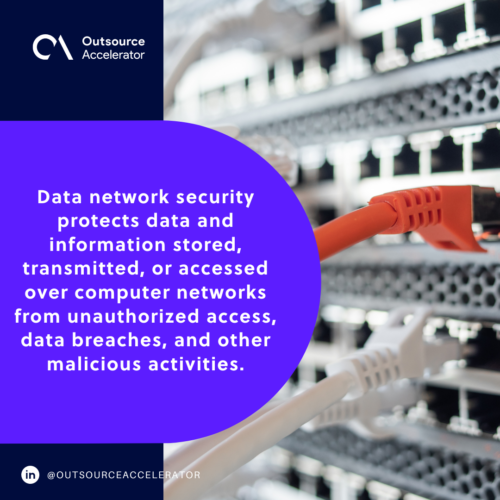Significance of data network security in safeguarding confidential data

With data as a critical asset in both personal and professional aspects, ensuring its security has become paramount.
Organizations and individuals face constant threats from cybercriminals and malicious actors who seek to exploit vulnerabilities and gain unauthorized access to sensitive information. The consequences of data breaches can be devastating.
Robust data network security measures are essential to mitigate these risks and maintain customers’ trust.
In this article, we’ll delve into the significance of data network security and explore the various components contributing to its effectiveness in protecting confidential data.
What is data network security?
Data network security protects data and information stored, transmitted, or accessed over computer networks from unauthorized access, data breaches, and other malicious activities.
It encompasses various technologies, processes, and policies that create a secure network environment, maintaining the following:
- Confidentiality – It ensures that access to confidential information is only available to authorized personnel.
- Data integrity – Data network security guarantees that data remains unchanged and uncorrupted during storage, transmission, or processing.
- Availability – It assures that data is accessible when needed, without disruptions or denials of service.

How does data network security protect data?
Here are the following ways data network security can safeguard your company information:
Network segmentation and isolation
Network segmentation involves dividing a network into smaller segments and restricting access between them. This creates barriers that prevent outside entities from gaining unrestricted access to critical systems and sensitive data.
Vulnerability assessments and penetration testing
Regular vulnerability assessments and penetration testing help identify network security weaknesses. This proactive data network security measure systematically scans networks and systems to discover web vulnerabilities that attackers could manipulate.
Organizations can significantly reduce the risk of successful breaches by addressing these vulnerabilities promptly.
Security information and event management systems (SIEM)
SIEM systems monitor and analyze network events and security logs in real-time. SIEM solutions enable organizations to swiftly detect and respond to security incidents by measuring and correlating data from various sources.
It provides valuable insights into network traffic, user behavior, and potential threats, empowering organizations to safeguard their data proactively.
Regular software updates and patch management
This data network security measure timely manages the installation of software updates and patches to help protect networks and applications from known vulnerabilities.
Effective patch management practices ensure that critical security patches are applied promptly and efficiently throughout the network so no threat actors can enter the system.
Application and database security measures
Applications and databases often store and process sensitive data, making them attractive targets for cybercriminals.
As such, it is part of application and database security measures to implement vigorous safety efforts such as:
- Secure coding practices
- Encryption
- Access controls
- Regular security audits
Moreover, database activity monitoring and data loss prevention solutions further enhance the protection of sensitive information.
Essential components of data network security
Understanding the building blocks that contribute to a robust and effective security framework is essential. These components create a layered defense that safeguards sensitive data from fraudulent activities:
Intrusion detection systems
Intrusion Detection Systems (IDS) are essential components of data network security. They monitor network traffic, analyzing it for any signs of suspicious or malicious activities.
IDS solutions are crucial in identifying potential intrusions and generating alerts to notify network administrators or security teams.
There are two main categories of IDS:
- Network-based IDS (NIDS) – It operates at key points within the network infrastructure, monitoring network traffic to identify patterns or anomalies that may indicate an intrusion attempt.
- Host-based IDS (HIDS) – This focuses on individual host systems, monitoring their activities for any signs of compromise or unauthorized access.
Virtual private networks
Virtual private networks (VPNs) ensure secure and encrypted connections over public or untrusted networks, such as the Internet. They establish a secure tunnel between a user’s device and a remote network, protecting data from interceptions and theft.
In other words, VPNs provide privacy and security by encrypting data traffic, making it unreadable to anyone who may try to intercept it. It adds a layer of data network security to network communications, enabling secure remote access to organizational resources.

Transport layer security
Transport layer security (TLS) is a cryptographic technology that enables safe network connection. It encrypts data transmitted between servers and clients, preventing eavesdropping, tampering, and data manipulation.
TLS is a widely used data network security component to secure various network-based applications, such as:
- Web browsing
- Email communication
- Online transactions
It employs symmetric and asymmetric encryption algorithms, providing confidentiality, integrity, and authentication. It also enables the client and the server to verify each other’s identities through digital certificates, ensuring the communication is trusted.
Authentication mechanisms
Authentication mechanisms play a critical role in verifying the identities of users and devices accessing a network. They ensure that only authorized individuals or devices can access network resources.
Strong authentication measures, such as multifactor authentication (MFA) and biometric authentication, enhance data network security by requiring other forms of identification.
MFA combines two or more authentication factors, such as passwords, security tokens, or biometrics, to authenticate users.
This data network security component significantly reduces the risk of unauthorized access, as an attacker must compromise multiple factors to impersonate a legitimate user.
Safeguard your information with a robust data network security
Organizations must understand the significance of implementing robust data network security measures to build a strong cyber defense system and maintain the trust of their stakeholders.
Adopting the abovementioned security comprehensive approach can create a solid defense system against persistent malicious actors.







 Independent
Independent




